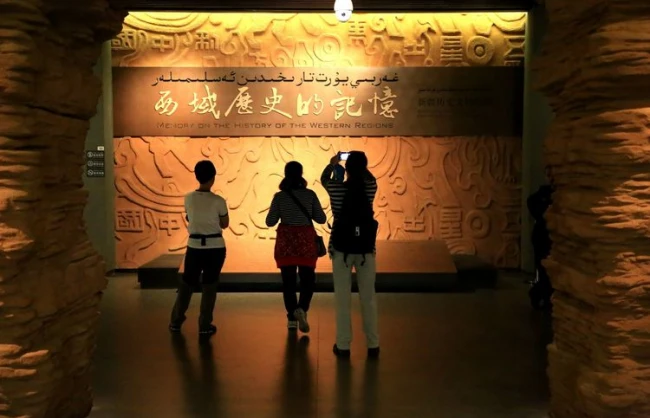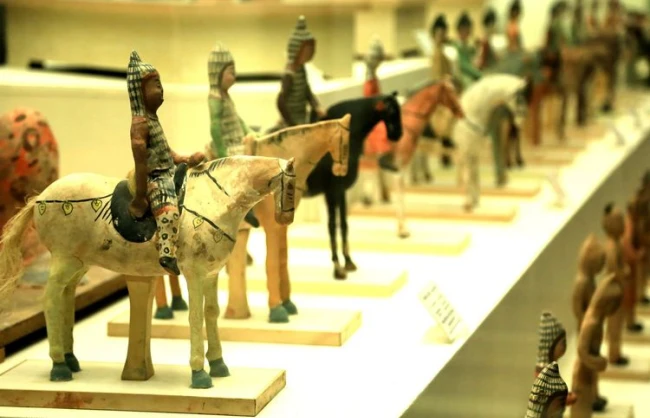Written by Veronica |
Xinjiang, also known as the Western Regions in ancient times, is located in the northwestern frontier of China and the heartland of Eurasia. The Regional Museum of Xinjiang is a must-visit spot during a Urumqi tour for anyone interested in exploring the region’s diverse cultural heritage.
Established in 1953, the Xinjiang Uyghur Autonomous Region Museum is the only provincial-level comprehensive local museum in the autonomous region. Awarded the status of a first-class national museum in 2008, Xinjiang Regional Museum holds over 40,000 artifacts, including 381 first-grade cultural relics.
Xinjiang Regional Museum Facts
- Address:581 Northwest Road, Shayibake District, Urumqi City
- Type: Museum, Silk Road Site, Landmark
- Best Time to Visit:All Seasons
- Time Needed: 2 – 3 hours
- Opening Hours:10:30 -18:00 (close on Monday)
- Tickets:Free Admission
- Suited To:People interested in Silk Road culture and Xinjiang history

Highlighs of Xinjiang Regional Museum
Xinjiang Regional Museum features several themed exhibitions, including “Ancient Xinjiang Historical Relics,” “Xinjiang Revolutionary Historical Materials,” “Xinjiang Ethnic Customs,” and “Ancient Mummies of Xinjiang.”
Xinjiang Historical Relics Exhibition
The Xinjiang Historical Relics Exhibition was launched on May 18, 2022, during the opening of the museum’s new Phase II building. It focuses on the history of ethnic interactions and integration, and the cultural exchanges along the Silk Road.
The exhibition brings history to life through nearly 2,000 carefully selected artifacts from the pre-Qin period to the Qing Dynasty, including nearly 500 new items unveiled to the public for the first time. These items, mostly from recent major archaeological discoveries in Xinjiang, systematically display the region’s brilliant historical culture and showcase the beauty of Chinese history, geography, and culture .
Xinjiang Ethnic Customs Exhibition
The Xinjiang Ethnic Customs exhibition comprehensively presents the folk cultural history of Xinjiang through photos, portraits, miniature architectural models, and historical documents. The exhibition displays nearly 800 pieces (sets) of high-quality artifacts and exhibits, covering traditional folk cultures of various ethnic groups such as the Uyghur, Kazakh, Kyrgyz, and Tajik. These exhibits in the Regional Museum of Xinjiang reflect aspects of daily life, traditional architecture, food and clothing, folk crafts, festivals, life rituals, and music and dance.
Xinjiang Revolutionary Historical Materials Exhibition
The Revolutionary Historical Materials exhibition of Xinjiang Regional Museum consists of four parts: “A New Beginning,” “A New Era,” “A Great Transformation,” and “A Profound Impact.” It includes revolutionary relics, photos, historical documents, and scene reconstructions. The exhibition displays over 200 revolutionary relics and 200 photos, divided into four sections to introduce the contributions and support of the Communist Party of China to Xinjiang’s development at different historical stages.
The Mummy Exhibition
Covering an area of over 700 square meters, the mummy exhibition hall in the Xinjiang Regional Museum not only displays several ancient corpses but also a large number of burial artifacts. Through photos, texts, and multimedia displays, visitors can gain a comprehensive understanding of the history and culture of these mummies.
In the field of archaeology, mummies are classified into several categories, including mummies, frozen bodies, jerked bodies, tanned bodies, and wet bodies. When it comes to mummies, the most well-known are the Egyptian mummies, which are artificially preserved through special techniques. However, the mummies unearthed in Xinjiang are quite different. They are naturally formed mummies in the dry environment of Xinjiang, without any artificial treatment.

What to Do in Xinjiang Regional Museum
Experience the Creative Fusion
The Xinjiang Regional Museum’s cultural and creative products (CCPs) blend artistic value with practicality, launching a series of visually appealing, fun, and meaningful items. These products cover daily use items, stationery, rural specialties, and food, with a total of 817 types and 46,905 sets. These CCPs allow visitors to connect with history and evoke memories even after their immersive museum experience.
Immerse in the Cultural Relics
The vast territory and the scattered distribution of immovable cultural relics in Xinjiang may limits visitors’ exploration sometimes. To response, the Xinjiang Regional Museum has leveraged technology to empower its exhibitions. Utilizing digital resources of its collections and interactive technologies such as VR and AR, the museum has created a fusion of virtual and real experiences.
Aiming to provide a “one-stop” journey through Xinjiang, the project integrates movable and immovable cultural relics in an organic and complementary manner. It allows visitors to experience the deep historical connections between different regions in an immersive way during their Xinjiang travels.
How to Get to Xinjiang Regional Museum
The Regional Museum of Xinjiang is easily accessible by public transportation, including buses and taxis. It is located in the Tianshan District of Urumqi, the capital of Xinjiang. The museum is very convenient to reach. In addition to taking a taxi, you can take bus No. 2 or No. 52 from the train station and get off at the Youyi Station. Walk through the Youyi Market, and you will arrive at the regional museum in Xinjiang. You can also take bus No. 51 from the airport, which goes directly to the museum.
Best Time to Visit Xinjiang
June to October are the best months to travel to Xinjiang. The grasslands and trees in Xinjiang are covered in green since June, and the climate becomes more pleasant. During this time, major scenic spots in Xinjiang begin bust tole with activity, and the entire region comes to life. By July and August, all the attractions in Xinjiang enter their peak viewing seasons. The vast, emerald green grasslands and shimmering lakes are truly captivating and leave visitors lingering with reluctance. These months see a surge in tourists, marking the peak season for travel in Xinjiang.
As September and October arrive, autumn in Xinjiang brings azure skies, bright sunshine, and comfortable temperatures. The forests and mountainous areas become particularly enchanting, with golden poplar forests, maple trees covered in red leaves, creating beautiful and picturesque scenes.
Attractions Nearby the Regional Museum of Xinjiang
If you have extra time, there are several attractions near the Xinjiang Regional Museum that are worth visiting, including:
- Red Hill Park: Red HillPark is a symbol and landmark of Urumqi, Xinjiang. With an elevation of 910.8 meters, the park is composed of purplish-red conglomerate, which gives it its reddish-brown appearance.
- International Grand Bazaar:The International Grand Bazaar is a massive indoor market that offers a glimpse into the local culture and traditions of Xinjiang. The market sells various goods, including textiles, handicrafts, and food.
Recommended Xinjiang Tours with Xinjiang Regional Museum
- 3 Days Urumqi Private Tour: Heavenly Lake, Bazaar…
- 10 Days Classic Southern Xinjiang Historic Tour – China Xian Tour
- 5 Days Best Urumqi-Kashgar Tour by Flight







